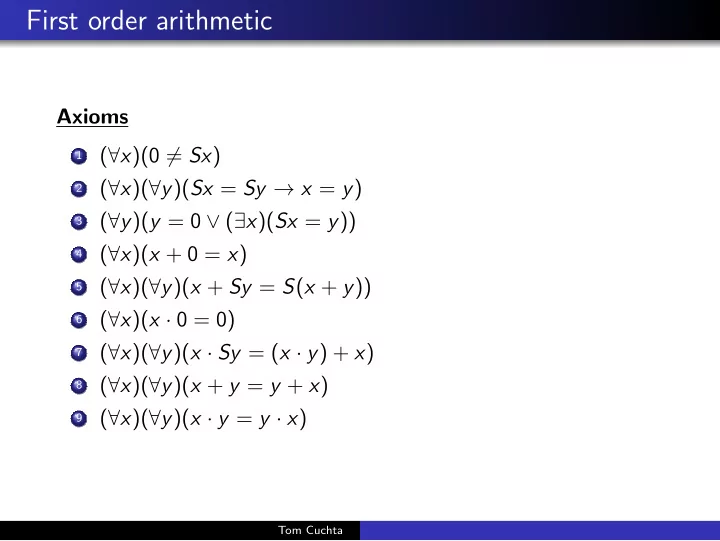

First order arithmetic Axioms 1 ( ∀ x )(0 � = Sx ) 2 ( ∀ x )( ∀ y )( Sx = Sy → x = y ) 3 ( ∀ y )( y = 0 ∨ ( ∃ x )( Sx = y )) 4 ( ∀ x )( x + 0 = x ) 5 ( ∀ x )( ∀ y )( x + Sy = S ( x + y )) 6 ( ∀ x )( x · 0 = 0) 7 ( ∀ x )( ∀ y )( x · Sy = ( x · y ) + x ) 8 ( ∀ x )( ∀ y )( x + y = y + x ) 9 ( ∀ x )( ∀ y )( x · y = y · x ) Tom Cuchta
First order arithmetic Prove in 1st order arithmetic: ( x + S 0) = SS 0 ↔ x = S 0. { Ax 5 } (1) ( ∀ y )( x + Sy = S ( x + y )) Axiom 5 US { Ax 5 } (2) x + S 0 = S ( x + 0) 1 US { Ax 4 } (3) x + 0 = x Axiom 4 US { Ax 4 , 5 } (4) x + S 0 = Sx 2 3 Identity Law { 5 } (5) ( x + S 0) = SS 0 Premise { 5 , Ax 4 , 5 } (6) SS 0 = Sx 4 5 Identity Law { Ax 2 } (7) ( ∀ y )( SS 0 = Sy → S 0 = y ) Axiom 2 US { Ax 2 } (8) SS 0 = Sx → S 0 = x 7 US { 5 , Ax 2 , 4 , 5 } (9) S 0 = x 6 8 Detachment { 5 , Ax 2 , 4 , 5 } (10) x = S 0 9 Identity { Ax 2 , 4 , 5 } (11) ( x + S 0) = SS 0 → x = S 0 5 10 C.P. { 12 } (12) x = S 0 Premise { 12 , Ax 5 } (13) ( x + S 0) = S ( S 0 + 0) 2 12 Identity Law { Ax 4 } (14) S 0 + 0 = S 0 Axiom 4 { 12 , Ax 4 , 5 } (15) x + S 0 = SS 0 13 14 Identity Law { Ax 4 , 5 } (16) x = S 0 → ( x + S 0) = SS 0 12 15 C.P. { Ax 2 , 4 , 5 } (17) ( x + S 0) = SS 0 ↔ x = S 0 11 16 Law of Biconditionals Tom Cuchta
First order arithmetic Sometimes it is useful to break a proof of a theorem down into constituent parts and then combine the parts. This can help “chunk” a longer proof into a sequence of simpler proofs. We could have proven ( x + S 0) = SS 0 ↔ x = S 0 in the following way: Theorem A : ( x + S 0) = SS 0 → x = S 0 Theorem B : x = S 0 → ( x + S 0) = SS 0 Notice in the previous slide, Theorem A was proven on line (11) and depends on Axioms 2, 4, and 5 and Theorem B was proven on line (16) and depends on Axioms 4 and 5. We allow ourselves to use theorems in a formal deduction by placing it on a new line (with proper documentation). Tom Cuchta
First order arithmetic Prove ( x + S 0) = SS 0 ↔ x = S 0 from Theorem A and Theorem B : { Ax 2 , 4 , 5 } (1) ( x + S 0) = SS 0 → x = S 0 Theorem A { Ax 4 , 5 } (2) x = S 0 → ( x + S 0) = SS 0 Theorem B { Ax 2 , 4 , 5 } (3) ( x + S 0) = SS 0 ↔ x = S 0 1 2 Law of Biconditionals Tom Cuchta
First order arithmetic Prove ( ∀ x )( x · ( x + S 0) = x · x + x ) in first order arithmetic. { Axiom 7 } (1) ( ∀ y )( x · Sy = ( x · y ) + x Axiom 7 US { Axiom 7 } (2) x · Sx = ( x · x ) + x 1 US { Axiom 5 } (3) ( ∀ y )( x + Sy = S ( x + y )) Axiom 5 US { Axiom 5 } (4) x + S 0 = S ( x + 0) 3 US { Axiom 4 } (5) x + 0 = x Axiom 4 { Axiom 4 , 5 } (6) x + S 0 = Sx 4 5 Identity Law { Axiom 4 , 5 , 7 } (7) x · ( x + S 0) = ( x · x ) + x 2 6 Identity Law { Axiom 4 , 5 , 7 } (8) ( ∀ x )( x · ( x + S 0) = ( x · x ) + x ) 7 UG Tom Cuchta
Recommend
More recommend